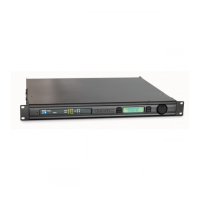EN
3
Introduction
1- Power indicator
2- Diagnostic indicator
3- Network status indicators
4- Port connection status indicators
5- Multi-function push buttons
6- Display
7- Rotary select/accept knob
8- Reset push switch (recessed)
9- DataPorts
10- Analog inputs
11- Monitor chain in/out
12- Relay outputs
13- Logic outputs
14- Omni inputs
15- RS-232 port
16- Network status indicators
17- QSControl 10BaseT receptacle
18- CobraNet 100BaseT receptacle
19- IEC power inlet
The BASIS 922az provides the digital audio transport, signal
processing, control and status monitoring facilities needed
to bind a group of amplifiers and loudspeakers into an inte-
grated functioning system. In conjunction with QSCon-
trol.net software, the BASIS 922az enables the user to
design, test and deploy professional audio reinforcement
and distribution systems ranging in size from one to hun-
dreds of channels.
Each QSC power amplifier connects directly to a BASIS
922az via one of its four QSC DataPorts. All mission-critical
elements of the BASIS-driven sound system are monitored.
User-selected events are logged and loudspeaker protection
features unique to BASIS such as QSC's Driver Defense™
power limiter are made possible through the DataPort func-
tionality.
A standard Windows computer is the principle user-inter-
face for controlling the overall BASIS/QSControl system.
However, the BASIS 922az also offers a front panel inter-
face for accessing a few critical functions.
A single QSControl server computer can support several cli-
ents running QSC's latest Venue Manager software. Thus,
the sound system can be operated via several computers,
roaming wireless laptops, tablets, etc., all at the same time,
from anywhere a connection to the QSControl network is
available.
The QSControl network can also be managed from a single
computer running both the client and the server. Once all
BASIS devices in a system are configured, a computer is no
longer required on that system’s network. All basic func-
tions of the BASIS 922az continue to operate with or with-
out a control computer connected to the network.
The configurable DSP engine provides all of the functions
necessary to handle B-chain (the amp/loudspeaker portion
of a single chain) such as very flexible and precise cross-
overs, delays, equalization, compression/limiting, etc.
Audio enters a BASIS 922az either through analog line
inputs or from CobraNet source devices such as QSC's line
of RAVE digital audio routers. Any combination of 16 Cobra-
Net channels (selected from up to 4 bundles of 32 channels)
can be routed into the 24 x 24 DSP engine. Any or all of the
24 DSP channels can also be routed to up to 32 CobraNet
channels on the network.
See page 14 for detailed descriptions.
Don’t want to read the entire manual? Just
want to dig right in? Go to page 18....

